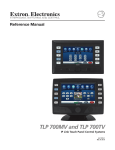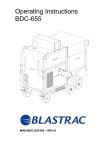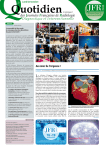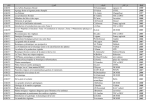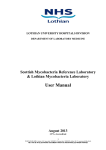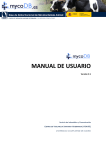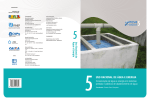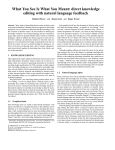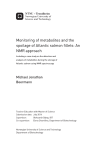Download Multilocus Variable Number Tandem Repeat - MIRU
Transcript
Multilocus Variable Number Tandem Repeat Genotyping of Mycobacterium tuberculosis Technical Guide Philip Supply INSERM U629 Institut de Biologie/Institut Pasteur de Lille May 2005 Acknowledgements I would like to thank first Camille Locht for his vision, continuous support and commitment for the development of mycobacterial Variable-Number Tandem Repeat typing. I would like also to thank especially Edith Mazars, Sarah Lesjean, Eve Willery, Caroline Allix, Mara Cardoso-Oeleman and Evgueni Savine for their valuable technical contribution, their work and personal dedication, as well as Vincent Vatin for providing us access to sequencers and for his expert advises in sequencer utilization. Marie-José Truong is thanked for her efficient organizational help. I gratefully acknowledge Maria Cristina Gutierrez for her support and for helpful discussions about the manual typing method, and Mickaël Vanrumbeke (Applera/Applied Biosystems France) for useful advises. Finally, I would like to thank the numerous collaborators involved in our work, and in particular, Kristin Kremer for the gift of her valuable reference strain collection. Without the persons mentioned above, the realization of this guide would not have been possible. To C., E., C., A. and A. Table of contents Table of contents..................................................................................................................................2 Preface..................................................................................................................................................4 1 Introduction....................................................................................................................................5 2 Methods..........................................................................................................................................7 2.1 DNA extraction and dilution .................................................................................................................................. 7 2.1.1 Principle .......................................................................................................................................................... 7 2.1.2 Procedure......................................................................................................................................................... 7 2.2 PCR amplification .................................................................................................................................................. 8 2.2.1 Principle .......................................................................................................................................................... 8 2.2.2 Procedure......................................................................................................................................................... 8 2.2.2.1 Preparation of a PCR spreadsheet ............................................................................................................ 8 2.2.2.2 Preparation of PCR premixes................................................................................................................... 9 2.2.2.3 Addition of genomic DNA ..................................................................................................................... 12 2.2.2.4 PCR amplification .................................................................................................................................. 12 2.3 PCR product analysis using agarose gel electrophoresis ..................................................................................... 13 2.3.1 Gel preparation and electrophoresis.............................................................................................................. 13 2.3.2 Sizing and allele assignation ......................................................................................................................... 14 2.3.3 Detection and interpretation of stutter peaks................................................................................................. 15 2.4 PCR product analysis using capillary electrophoresis ......................................................................................... 17 2.4.1 Principle ........................................................................................................................................................ 17 2.4.2 Capillary electrophoresis............................................................................................................................... 17 2.4.2.1 Dye set and spectral calibration ............................................................................................................. 18 2.4.2.2 Preparing the samples............................................................................................................................. 18 2.4.2.3 Editing or creating a specific run module .............................................................................................. 19 2.4.2.4 Creating a plate record template............................................................................................................. 20 2.4.2.5 Importing plate record tab files generated with Excel ........................................................................... 26 2.4.2.6 Preparing and placing a plate assembly ................................................................................................. 28 2.4.2.7 Linking a plate........................................................................................................................................ 30 2.4.2.8 Launching and controlling the run ......................................................................................................... 31 2.4.2.9 Monitoring the run status ....................................................................................................................... 33 2.5 PCR product sizing using Genescan .................................................................................................................... 34 2.5.1 Principle ........................................................................................................................................................ 34 2.5.2 Procedure....................................................................................................................................................... 34 2.5.2.1 Creating a GeneScan project .................................................................................................................. 34 2.5.2.2 Setting analysis parameters and size standard reference........................................................................ 36 2.5.2.3 Analyzing sample files ........................................................................................................................... 40 2.6 Editing sizing data and assigning alleles using Genotyper .................................................................................. 42 2.6.1 Principle ........................................................................................................................................................ 42 2.6.2 Procedure....................................................................................................................................................... 42 2.6.2.1 Opening templates and checking import preferences ............................................................................ 42 2.6.2.2 Importing GeneScan files....................................................................................................................... 44 2.6.2.3 Main window and other windows of interest ......................................................................................... 45 2.6.2.4 View, dye/lane sorting, and peak labeling options................................................................................. 49 2.6.2.5 Running Macros and viewing results ..................................................................................................... 51 2.6.2.6 Verifying size standard assignation and peak information .................................................................... 52 2.6.2.7 Detecting and removing Genotyper labels from problematic peaks ...................................................... 53 2.6.2.7.1 Incorrectly sized peaks .................................................................................................................... 54 2.6.2.7.2 Pull-up peaks ................................................................................................................................... 55 2.6.2.7.3 Peak shoulders or mirror peaks ....................................................................................................... 57 2.6.2.7.4 Spurious peaks................................................................................................................................. 57 2.6.2.7.5 Cross-talks between flanking capillaries (for 3700 and 3730)........................................................ 58 2.6.2.7.6 Stutter peaks .................................................................................................................................... 59 2.6.2.8 Adding labels to true alleles ................................................................................................................... 60 2.6.2.9 Genuine co-migration between PCR products tagged with different dyes ............................................ 61 2.6.2.10 Genuine double alleles ......................................................................................................................... 61 2.6.2.11 Viewing and analyzing the second half of the capillary lanes ............................................................. 62 2.6.2.12 Final sorting by file names ................................................................................................................... 62 2.6.2.13 Creating final results tables and verifying results ................................................................................ 62 2.6.2.14 Exporting final table to Excel............................................................................................................... 64 2 2.7 Size offset calibration........................................................................................................................................... 64 3 Bibliographic References.............................................................................................................66 4 Appendixes...................................................................................................................................69 4.1 4.2 4.3 4.4 4.5 Conventional and alias designations of MIRU-VNTR loci ................................................................................. 69 PCR primer sequences ......................................................................................................................................... 70 Reagent and material references .......................................................................................................................... 71 Allele calling table and H37Rv MIRU-VNTR genotype ………………………………………………………72 Alternative PCR conditions for mix 5………………………………………………………………………….73 3 Preface What you should know before beginning: This manual is written for principle investigators and laboratory staff who are planning to perform Variable Number Tandem Repeat genotyping of Mycobacterium tuberculosis complex isolates, using agarose gel electrophoresis or using a 3100 Genetic Analyzer. Although the general principles are the same, some adaptations may be needed for 3130, 3100 Avant, and 3700 and/or other software versions. Before attempting the procedures in this manual, you should be familiar with the following topics: 1. General techniques and safety procedures for obtaining and handling Mycobacterium tuberculosis complex isolates. 2. General techniques and safety procedures for handling DNA samples, performing PCR, preparing PCR products for electrophoresis, and performing electrophoresis. 3. Windows operating systems 4. The basics for installing, operating and maintaining a 3100 Genetic Analyzer. Detailed information for these procedures are given in Applied Biosystems’ manuals. 4 1 Introduction Variable Number Tandem Repeat (VNTR) sequences have emerged as valuable markers for genotyping of several bacterial species, especially for genetically homogeneous pathogens such as Bacillus anthracis (1, 2), Yersinia pestis (2, 3) and the M. tuberculosis complex members (see below). VNTR genotyping basically rely on PCR amplification using primers specific for the flanking regions of the VNTRs and on the determination of the sizes of the amplicons, after electrophoretic migration. As the length of the repeat units is known, these sizes reflect the numbers of the amplified VNTR copies. The final result is a numerical code, corresponding to the repeat number in each VNTR locus. Such numerical genotypes are intrinsically portable and are thus particularly convenient for both intra- and inter-laboratory comparative studies (4, 5). In addition, compared to IS6110-RFLP, MIRU-VNTR typing has the advantages of being faster, and appropriate for virtually all M. tuberculosis isolates, including strains that have a few IS6110 copies (4, 5). Initial VNTR typing systems for M. tuberculosis complex strains made use of very limited sets of loci (4, 6-9), which turned out to not be sufficiently discriminatory (10). More extensive sets of VNTR loci have been described subsequently (11-15), including a system based on 12 loci (14), which has been shown to be applicable for reliable genotyping and molecular epidemiology studies of M. tuberculosis (5, 16). These loci contain VNTR of genetic elements named Mycobacterial Interspersed Repetitive Units (MIRUs) that are located mainly in intergenic regions dispersed throughout the M. tuberculosis genome (14, 16, 17). As the other VNTRs sequences mentioned above, the lengths of MIRU repeat units are in the range of 50-100 bp, and belong therefore to the “minisatellite” VNTR category (16). All above loci are collectively designated as MIRU-VNTR loci in this guide. A MIRU-VNTR-based high-speed genotyping system has been developed, which combines the analysis of multiplex PCRs for the target loci on a fluorescence-based DNA analyzer with computerized automation of the genotyping (16). Both this system and the simpler system using electrophoresis with agarose gels are highly reproducible at intra- and inter-laboratory levels (14, 5 18). A recent population-based study indicated that the use of the 12 locus-based MIRU-VNTR typing as a first-line method, together with spoligotyping, provides adequate discrimination in most cases for large-scale, prospective genotyping of Mycobacterium tuberculosis in the United States. IS6110 fingerprinting can subsequently be used as a secondary typing method to type the clustered isolates, when additional discrimination is needed (19). Other studies have shown the interest of this typing method for clinical mycobacteriology (e.g. 20) or for local outbreak investigation (21). In order to further reduce the numbers of isolates to be analyzed by IS6110 fingerprinting, we have recently evaluated the additional information provided by a set enlarged to 29 loci, using a total of 824 tubercle bacillus isolates, including representatives of the main lineages identified worldwide so far (Supply et al., in preparation). Five loci (i.e. QUB-3232, -3336, -1895, -18 (alias VNTR 1982), -11a (alias VNTR 2163a)) were excluded for lack of robustness and/or stability in serial isolates or isolates from epidemiologically-linked patients. The use of the 24 remaining loci increased the number of types by 40% - and by 23% in combination with spoligotyping - among isolates from cosmopolitan origins, as compared to those obtained with the original set of 12 loci. Consequently, the clustering rate was decreased by four-fold – by three-fold in combination with spoligotyping - under the same conditions. A discriminatory subset of 15 loci with the highest evolutionary rates was then defined, that concentrated 96 % of the total resolution obtained with the full 24-loci set. Its predictive value for evaluating M. tuberculosis transmission was found to be equal to that of IS6110 RFLP typing, as shown in a companion population-based study. This 15-loci system is therefore proposed as the new standard for routine epidemiological discrimination of M. tuberculosis isolates, and the 24-loci system as a high-resolution tool for phylogenetical studies (Supply et al., J. Clin. Microbiol., in press). A table giving the correspondence between different nomenclatures for the 24 loci retained is given in Appendix 4.1. 6 2 Methods Note: Aerosol resistant pipet tips are used at all experimental steps before PCR amplification, to avoid potential contamination problems. 2.1 DNA extraction and dilution 2.1.1 Principle As it is based on amplification by PCR, MIRU-VNTR typing can be performed on heat inactivated mycobacterial colonies or mycobacterial pellets from liquid cultures without extensive DNA purification. It can be applied to various biological materials, including non-viable material, permitting for instance retrospective analyses of stocks of non-viable cells. Note: alternatively, purified DNA obtained by the internationally standardized method as described by van Soolingen et al. (22) or by other standard methods for IS6110-RFLP analysis can also be used. 2.1.2 Procedure 1. Resuspend mycobacterial colonies grown on solid media (e.g. Löwenstein-Jensen) medium or mycobacterial pellets obtained from liquid cultures (e.g. MGIT) into 200 µl 10 mM Tris-HCl, 1 mM EDTA (pH 7.0), in a screwed cap tube or a safe lock tube. 2. For colonies recovered from solid media, go to step 3. Re-centrifuge mycobacterial pellets obtained from liquid cultures at 15,000 g x 5 min, discard the supernatant and resuspend the bacterial pellet into 200 µl 10 mM Tris-HCl, 1 mM EDTA (pH 7.0). 3. Incubate at 95°C for 45 min, using an oven or a PCR cycler with a hot lid, if available in the microbiological security facility. 4. Centrifuge the suspension at 15,000 g x 1 min, to pellet the cell debris. 5. Harvest the supernatant containing the DNA and transfer into a new tube. 6. Store concentrated stocks at –20 °C until further use, or dilute at 1:50 into sterile water in a new tube. Diluted solutions can be also stored at -20 °C. 7 2.2 PCR amplification 2.2.1 Principle PCR amplification of different VNTR regions is performed using primers specific for the flanking regions of each VNTR region. When analysis of the PCR products is done using a DNA sequencer, 8 different multiplex PCRs are performed in order to analyze eight groups of three loci simultaneously. For each multiplex, one primer per oligonucleotide pair is tagged with a specific fluorescent dye (appendix). In case of amplification failure of some loci in some multiplex reactions, these loci are then usually amplified separately by simplex PCR, in a second round. When analysis of the PCR products is done using only electrophoresis with agarose gels, separate amplification of each locus is performed, using unlabeled oligonucleotides. 2.2.2 Procedure 2.2.2.1 Preparation of a PCR spreadsheet 1. Prepare a PCR spreadsheet, indicating the position of each sample in the PCR 96well microplate (Figure 1). 2. If different multiplex or simplex PCRs are performed in a same microplate, use specific extensions after sample names (e.g. sample 1-mix1) or use different colors to specify the different reactions, as shown in the example below. Samples analyzed with the same multiplex or the same locus should be grouped together for convenience. 3. Include positions for a negative control (sterile water) and a positive control (H37Rv or BCG Pasteur) for each multiplex or simplex set, to validate the analysis. 8 Figure 1 PCR spreadsheet model H G F E D C B A Sample 1 Sample 2 Colour code: 1 2 3 Mix 1 Mix 2 4 5 6 7 8 9 10 11 12 2.2.2.2 Preparation of PCR premixes PCR premixes can be prepared extemporaneously just before the addition of genomic DNA, or stock solutions can be prepared, aliquoted and stored at -20°C until further use. The final concentration of MgCl2 varies from 1.5 mM (default concentration using the 10 X buffer) to 3 mM (by including additional MgCl2), according to the multiplex or the MIRU locus. The final volume per reaction (after addition of DNA) is 20 µl. The use of Qiagen Hotstart Taq Polymerase kit including Q solution is strongly recommended. If this kit is not used, PCR failures may be observed, especially for MIRU-VNTR locus 20, and more intense stutter peak ladders (see below) may be seen, leading to possible misinterpretation problems. Note: the Qiagen PCR Multiplex PCR kit may be specifically used for mix 5, to reduce pronounced stutter peaks seen with large alleles of locus 4052 (see Annex 5). Using our conditions, Q solution is the limiting reactive in the Qiagen kit. However, the use of Betaine (identical to Q coumpond, according to Sigma) at a final concentration of 1M in replacement of Q solution is a good and cheap alternative. 1. In a DNA-free area, prepare the PCR reaction premixes for the different multiplex and simplex reactions, according to Table 1, Table 2, and Table 3. Important: to take into account void volumes, prepare a 5-10 % proportion in excess of the volume needed. 9 2. Label a 96-well PCR microplate with date and experiment numbers. Mark the middle of the microplate for better visualization of the positions. Optionally, indicate separations between zones with different multiplexes as shown in Figure 2. 3. Dispense 18 µl of the PCR premix into each well of the microplate. Figure 2 Delineation of different multiplex zones on PCR microplate Table 1 Volumes (µl) for the discriminatory multiplex premixes a mix 1 2 3 4 5 Loci 4-26-40 10-16-31 MgCl2 final concentration H2O Buffer 10 X Q Solution 5x MgCl2 25 mM 3mM 2mM 0424- 05772165 1,5 mM 2401-36904156 3mM 2163b- 19554052 1,5 mM 7,5 2 4 1,2 8,3 2 4 0,4 8,7 2 4 0 7,5 2 4 1,2 8,7 2 4 0 DNTP 5mM 0,8 0,8 0,8 0,8 0,8 Primers EACHa Hotstart DNA pol 0,4 0,08 0,4 0,08 0,4 0,08 0,4 0,08 0,4 0,08 Total premix 18 18 18 18 18 Six in total, i.e. one forward and one reverse primer for each of the 3 pairs. Initial concentration for all unlabeled primers: 20 pmol/µl. Initial concentration for the labeled oligonucleotides: 2 pmol/µl for locus 0577, 3690 and 1955, 8 pmol/µl for locus 4052, 20 pmol/µl for locus 4156 and 4 pmol/µl for the other loci. See appendix for the primer sequence and labeling. Note: the Qiagen PCR Multiplex PCR kit may be specifically used for mix 5, to reduce pronounced stutter peaks seen with large alleles of locus 4052 (see Annex 5). 10 Table 2 Volumes (µl) for the other multiplex premixes a mix 6 7 8 Loci 2-23-39 20-24-27 MgCl2 final concentration 2.5 mM 1,5 mM 2347-24613171 2mM H2O Buffer 10 X Q Solution 5x MgCl2 25 mM 7,9 2 4 0.8 8,7 2 4 0 8,3 2 4 0,4 DNTP 5mM 0,8 0,8 0,8 Primers EACHa Hotstart DNA pol 0,4 0,08 0,4 0,08 0,4 0,08 Total premix 18 18 18 Six in total, i.e. one forward and one reverse primer for each of the 3 pairs. Initial concentration for all unlabeled primers: 20 pmol/µl. Initial concentration for all labeled oligonucleotides: 4 pmol/µl. See appendix for the primer sequence and labeling. Table 3 Volumes (µl) for the simplex PCR premixes a Loci 4-26-402401-36904156 10-16-312347-24613171 2mM 20-24-270424- 05772165-2163b1955- 4052 1,5 mM MgCl2 final concentration 3mM H2O Buffer 10 X Q Solution 5x MgCl2 25 mM 2-23-39 2.5 mM 9,1 2 4 1,2 9,9 2 4 0,4 10,3 2 4 0 9,5 2 4 0.8 DNTP 5mM 0,8 0,8 0,8 0,8 Reverse primera Forward primera Hotstart DNA pol 0,4 0,4 0,08 0,4 0,4 0,08 0,4 0,4 0,08 0,4 0,4 0,08 Total premix 18 18 18 18 See tables above for the initial concentration. When analysis of the PCR products is performed using only agarose gel electrophoresis (manual typing), all primers are unlabeled. 11 2.2.2.3 Addition of genomic DNA 1. In another PCR product-free area, dispense 2 µl of extracted DNA previously diluted 1:50 into each well. If purified DNA is used, dispense 2 µl of solution at 1 ng/µl. Include H37Rv DNA and sterile water as positive and negative controls, respectively. 2. Tightly seal the PCR microplate using an adhesive PCR film, to avoid evaporation during amplification. 2.2.2.4 PCR amplification 1. Amplify the target loci using the PCR conditions indicated in Table 4. These conditions have been successfully tested on Hybaid PCR express and Perkin Elmer cyclers. 2. For analysis on automated sequencers, notice that the number of cycles may need to be adjusted depending on the DNA concentrations routinely obtained in the laboratory, i.e. amplification from weakly or highly concentrated mycobacterial cultures may require 40 cycles or only 25 (Mix 1, 2, 4, 6, 7, 8) to 30 (Mix 3, 5) cycles, respectively. 3. Store the PCR products at 4°C or -20°C until further use. Table 4 PCR cycling conditions 15 min 1 min 1 min 1 min 30s 10 min ∞ 95°C 94°C 59°C 72°C 72°C 4°C 12 Cycle numbers: - Automated typing: 30 for Mix 1, 2, 4, 6, 7, 8 35 for Mix 3 and 5 - Manual typing: 40 cycles for all mixes 2.3 PCR product analysis using agarose gel electrophoresis When each locus is amplified separately (i.e. by simplex PCR), the amplified fragments can be analyzed by electrophoresis using agarose gels. This method is inexpensive and easy, as it only requires a size resolution of about 50 bp (except for locus 4, see below). It is accurate, provided that adequate electrophoresis conditions and controls are used. It is suitable for laboratories with relatively low turnovers of isolates to be analyzed. The use of multi-channel pipettes compatible with gel combs is useful for both the speed and the reliability of the genotyping process. This method is also used to size PCR fragments from reference strains, (in addition to H37Rv), selected to sample the allelic range of each MIRU-VNTR locus. When labeled with fluorescent dyes, the corresponding reference PCR products can then be used to calibrate the sizing using electrophoresis with your DNA sequencer. The quality of the DNA fragment resolution and the use of a control for possible migration smiling effects are critical for the sizing accuracy. Therefore, long gels and sufficient electrophoresis time should be used. The use of Nu-Sieve agarose gels offering high resolution for small DNA fragments is recommended, especially for the detection of variant alleles in locus 4. However, electrophoresis grade agaroses such as Ultra Pure Electrophoresis Grade Agarose from Gibco-BRL can yield satisfactory results. 2.3.1 Gel preparation and electrophoresis 1. Prepare a 3 % suspension of Nu-Sieve agarose gel in 1 x TBE solution previously chilled at 4°C, to facilitate clump collapse. 2. Melt the agarose using a microwave oven, and agitate periodically until complete dissolution. 3. When the temperature is endurable to the touch, cast a 25-cm gel, using a shark tooth comb. 4. After solidification, place the gel into an electrophoresis tank containing 1 X TBE. 13 5. Load 10 µl of a 100-bp ladder size standard marker in both external wells and in the central well of the gel. The standard in central position can be used to detect possible migration smiling effects. A 50-bp ladder or a 20-bp ladder (however less easy to read sometimes) can be used in addition. 6. For each reaction, load, per well, a mixture of 2 ml of PCR product with 2 ml of loading buffer. Migrate amplicons from a given locus together on a same gel, rather than migrating different loci from a same isolate on a same gel. By this way, allelic assignation is facilitated by visualization of the band ladders generated by different repeat numbers (see 2.3.2). 7. Run at 120 V for 5 hours. 8. Stain the gel in sterile water containing 0.7 µg/µl of ethidium bromide for 1530 min. 9. Expose the gel to UV light and take a photo. 2.3.2 Sizing and allele assignation Most often, amplification results in single sharp PCR products (Figure 3). Depending on the locus, this sharp amplicon can be accompanied by a ladder of much lower intensity bands, called stutter peaks (see 2.3.3 and Figure 4). However, some problematic amplification of loci with large repeat numbers can result in a ladder of bands, with no clearly sharpest band or with a “bell-shaped” distribution of band intensities (see 2.3.3). In this case, do not assign any result and re-amplify. 1. Determine the size of the sharp PCR product by comparison with the position of the size standard marker. 2. Determine the corresponding repeat number, using the provided table containing the allele calling for each VNTR locus, as shown in Figure 3. Verify the consistence with the usual allelic range. 3. Verify that the allele assignation of the H37Rv control is correct. 4. Verify the consistence of the results by judging the incremental spacing between PCR products from different isolates (i.e. co-migrating fragments = 14 same alleles, fragments smaller by one repeat increment = allele-1, etc). This control is best done starting from the smallest amplicon, as sizing is usually more accurate for small products. 5. If classical stutter peak ladders (see 2.3.3 and Figure 4) are present, they can also be used as internal sizing controls to verify the consistency of the allele assignation. Similarly, this control is best done starting from the smallest stutter peak. Figure 3 Example of allele identification for MIRU-VNTR locus 40 700 pb 600 pb 500 pb 400 pb Allele MIRU 40 0 354 1 408 2 462 3 516 4 570 5 624 6 678 7 732 2.3.3 Detection and interpretation of stutter peaks Stutter peaks are common during genotyping of tandem repeat sequences, and mostly reflect artifactual strand slippage of the polymerase during PCR. Such stutter peaks are also quite frequently observed for PCRs of various MIRU-VNTR loci, more often when containing large repeat numbers. In most cases, they can be easily diagnosed, as they appear as a ladder of much lower intensity peaks, corresponding to sizes of PCR fragments that lack one or more repeats, or more rarely that contain one or more additional repeat. The positions of stutter peaks can be used to confirm the allelic assignation of the principle fragment (see point 5 in 2.3.2). As indicated above, sub-optimal amplification of loci with large repeat numbers (such as 4052, alias QUB 26) can sometimes result in a band ladder with no clearly sharpest band or with a “bell-shaped” distribution of band intensities (see next section). This can be typically seen when the 15 Q buffer is not used. In this case, do not assign any result and re-amplify. Optimal amplification will often result in a single sharp band, with a highest size than could perhaps have been anticipated based on the initial band ladder pattern. Figure 4 Example of stutter peak detection in a MIRU-VNTR The example shown corresponds to amplicons from MIRU-VNTR locus 27. Dotted arrows show positions of stutter peaks. The size increments between the stutter peaks correspond to the size of one repeat unit (53 bp in this case). The size standard (M) is a 20-bp ladder. M Allele MIRU 27 0 498 1 551 2 604 3 657 4 710 5 763 500 bp Figure 5 Example of “bell-shaped” ladder The example shown corresponds to fragments amplified from MIRU-VNTR locus 4052 (alias QUB-26). Arrows show positions of stutter peaks. The size increments between the stutter peaks correspond to the size of one repeat unit (111 bp in this case). M, size standard (M). M 1000bp 800bp 600bp 400bp 200bp 16 2.4 PCR product analysis using capillary electrophoresis 2.4.1 Principle The PCR fragments labeled with the three different fluorescent dyes from each multiplex are combined with an internal size standard, labeled by a fourth dye and then analyzed in individual capillaries on a DNA sequencer for size determination. 2.4.2 Capillary electrophoresis The procedure is described for ABI 3100 sequencers, using the Data Collection software version 1.1. It is applicable to 3100 Avant and/or to software versions 2.x with minimal adaptations. Some additional adaptations may be needed for 3130, and 3700 and/or other software versions. A summary flowchart of a typical sequencer run is displayed in Figure 6. Operations specific to MIRU-VNTR typing are described starting from sample preparation (see arrow in Figure 6). Information for spectral calibration for the current dye set used in MIRU-VNTR typing is given in 2.4.2.1. Figure 6 Summary flowchart of a typical sequencer run (From ABI PRISM® 3100 Genetic Analyzer User Guide) Starting point 17 2.4.2.1 Dye set and spectral calibration If not done yet for other types of fragment analysis, initial spectral calibration is required for the appropriate detection of the current dye set used in MIRU-VNTR analysis. This combination of dyes (6FAM™, VIC®, NED™, for the amplicons, and ROX™ for the size standard) corresponds to dye set D on ABI sequencers. This spectral calibration is performed using ABI DS-31 Matrix Standard Kit, containing 4 oligonucleotides respectively labeled with these 4 dyes, pre-pooled in a single tube. Spectral calibration procedure is described in the instructions for use and in the sequencer user guide. 2.4.2.2 Preparing the samples Information on how samples are scheduled for injection based on plate configuration is provided in Figure 7. Figure 7 96-well plate mapping (From ABI PRISM® 3100 Genetic Analyzer User Guide) The sample are prepared as follows: 18 1. Dispense 1 µl of PCR product into the wells of a plate adapted for the ABI sequencer (e.g. Semi-skirted PCR plates, Sorenson, BioScience). Verify that each well contains solution. 2. Prepare extemporaneously a mix of 10 µl of formamide (Applied Biosystems) and 0.2 µl of MapMarker 1000 ROX™ size standard (BioVentures), per sample. 3. Dispense 10 µl of this mix into the wells of the plate. Verify that each well contains solution. 4. Tap down or centrifuge the plate so that each sample is positioned at the bottom of its well. Air injection should be avoided. Therefore your sample should: (From ABI PRISM® 3100 Genetic Analyzer User Guide) 5. Keep the plate at 4°C until you are ready to prepare the plate assembly and place the assembly on the autosampler. (note: such DNA/formamide mixtures can be kept for a few days, but no longer than one week at 4°C). 2.4.2.3 Editing or creating a specific run module Create a specific run module, called GS36_POP4_3000sec, as decribed in Figure 8, according to parameters in Table 5. 19 Figure 8 Creating a specific module (From ABI PRISM® 3100 Genetic Analyzer User Guide) Select GeneScan36_POP4DefaultModule Enter GS36_POP4_3000sec Table 5 Run module parameters for ABI 3100, 3100 Avant Run Temperature: 60 degrees Cap Fill Volume: 184 steps Current Tolerance: 100 micro Amps Run Current: 100 micro Amps Voltage Tolerance: 0.6 kVolts Pre Run Voltage: 15 kVolts Pre Run Time: 180 sec Injection Voltage: 1 kVolts Injection Time: 22 sec Run Voltage: 15 kVolts Number of Steps: 10 nk Voltage Step Interval: 60 sec Data Delay Time: 1 sec Run Time: 3000 sec 2.4.2.4 Creating a plate record template Plate records (or sample sheets) are data tables that store information about the plates and the samples they contain. Specifically for fragment analysis, a plate record contains the following information: ♦ Plate name, type, and owner 20 ♦ Position of the sample on the plate (well number) ♦ Sample name ♦ Dye color of size standard ♦ Comments about the plate and about individual samples ♦ Dye set information ♦ Project name (this entry is mandatory, even when Sequence Collector is not used) ♦ Name of the run module (run modules specify information about how samples are run) ♦ Name of the analysis module (analysis modules specify how raw data is auto-analyzed at the end of the run). Auto-analysis is usually not performed. Plate records can be generated using the Data Collection software, by following the steps in Figure 9. Specific notes for MIRU-VNTR analysis are indicated in bold. Do not forget to fill in color info with sample name for each color. This information is needed to create tables with final results in Genotyper templates. Alternatively, plate records can be conveniently created using Excel and then subsequently imported as tab files (see next section). 21 Figure 9 Creating a plate record for fragment analysis (From ABI PRISM® 3100 Genetic Analyzer User Guide) Figure 9 (continued) 22 Important ! Not applicable Size standard color is red (ROX) Important ! 23 Figure 9 (continued) Important ! Use Ctr+D To fill down Select D Select GS36_POP4_ 3000sec Choose selection no Figure 9 (continued) 24 Sample 1 Sample 1 Sample 1 Sample 1 Sample 1 Fill color info with sample name for each color Sample 2 Sample 2 Sample 2 Sample 2 Sample 2 Sample 3 Sample 3 Sample 3 Sample 3 Sample 3 Sample 4 Sample 4 But not applicable for Data Collection version 3.x Must be entered in Genotyper See 2.6.2.4a Sample 4 Sample 4 Sample 4 Sample 5 Sample 5 Sample 5 Sample 5 Sample 1 Sample 1 Sample 1 Sample 1 Sample 1 Sample 1 Sample 1 Sample 1 Sample 1 25 2.4.2.5 Importing plate record tab files generated with Excel 1. Create an Excel table following the model shown in Figure 10. Type sample names in cells B4 to B483. Add extensions to sample names, if different multiplex or loci are used in a same plate (e.g. -M1 for Mix 1, -04 for locus 4). Do not use spaces, or punctuation incompatible with PC file name formats. 2. Select the sample name cells, Copy (Ctrl+C) and Paste (Ctrl+V) these cells into cells F4 to F483. This will be useful to retrieve samples in Genotyper. 3. For positions containing no samples, type a 0 into all corresponding sample name cells for the five colors. Figure 10 Plate record model using Excel Run comment Run name 4. Save it as a tab-delineated file (.txt). 5. In Data Collection Software, click Plate View tab, then click Import (see Figure 11). 6. Select all types (*.*) from files of type. 7. Select your plate and click OK. 26 8. Double click on the pending plate and verify that the record is correct and complete (see example in step 9 of Figure 9). 9. If positions contain no sample (now indicated by a 0 after plate record importation), click on the Run Module cell of the first empty well and select No Run Module. Select the first and last empty positions by pressing Shift key, and then press Ctrl+D to fill down. Figure 11 Plate record importation and checking (From ABI PRISM® 3100 Genetic Analyzer User Guide) 27 2.4.2.6 Preparing and placing a plate assembly Verify the absence of any air bubble in plate wells. If needed, centrifuge the plate to remove them. Prepare a plate assembly and place it on the Autosampler by carefully following the steps described in Figure 12. Figure 12 Plate assembly and placing onto the Autosampler (From ABI PRISM® 3100 Genetic Analyzer User Guide) 28 29 2.4.2.7 Linking a plate A link must be created between the plate on the auto-sampler and the corresponding plate record, before a run can be performed. This procedure and the verification of the run schedule are described in Figure 13. Figure 13 Linking a plate and viewing the run schedule (From ABI PRISM® 3100 Genetic Analyzer User Guide) 30 2.4.2.8 Launching and controlling the run The procedure for starting and controlling a run is displayed in Figure 14. 31 Figure 14 Launching and controlling a run (From ABI PRISM® 3100 Genetic Analyzer User Guide) 32 2.4.2.9 Monitoring the run status The run status can be monitored by clicking the Status View tab. An example of Status view page is provided in Figure 15. Figure 15 Example of Status View page (From ABI PRISM® 3100 Genetic Analyzer User Guide) 33 2.5 PCR product sizing using Genescan After electrophoresis, the sizes of the PCR fragments are estimated using the GeneScan Analysis software (Applied Biosystem). Size data editing and automated conversion of these data into MIRU-VNTR alleles is only done subsequently, using customized templates of the Genotyper software (see next section). The procedure described below is based on GeneScan version 3.7.1. IMPORTANT: this version must be initially updated with GeneScan version 3.7.1 Updater and switched to Large Fragment Analysis using Large Fragment Enabler, as indicated in the ReadMe instructions included the Updater CD. 2.5.1 Principle The GeneScan Analysis software is used to calculate the apparent sizes of the PCR products, by correlating their migration data (in terms of laser scan numbers needed for detection in the CCD window) to those of size standard bands. 2.5.2 Procedure 2.5.2.1 Creating a GeneScan project 1. Open Genescan 2. From the main menu, click File, then New. 34 3. Click Project on the window as displayed below, to open the Analysis Control Window. 4. Click Project from the main menu, and then Add Sample Files. 5. Select the folder containing the sample files, and then click Add All, then Finish. 35 2.5.2.2 Setting analysis parameters and size standard reference 6. Double click on a Sample File and then click at the bottom of the pop-up window, to visualize an electropherogram which should look like the example below. 7. Using the zoom and the pointer , visualize and notice the scan numbers (X) corresponding to the zone immediately after the primer peak, and to the end of the run, respectively. This range should include all size standard peaks (in red) starting from 50 bp (see below for the size standard definition). Primer peak Scan numbers (X) Peak heights (Y) 50 bp size standard peak peak 150 bp size standard peak peak 8. Close the electropherogram window. Double-click any Analysis Parameters cell, to open the Analysis Parameters window. 36 9. Define the start and stop of the analysis range by introducing the scan numbers corresponding to the zone comprised between the primer peak and the 50 bp peak, and just before to the end of the run, respectively. Define the other parameters as shown below. 10. Save as Analysis Parameters. This file will then be used as default. 11. Note: Peak amplitude thresholds, defining the minimum peak height detection, can be subsequently increased if higher backgrounds are noticed for some samples. In this case, save the modified analysis parameters under a new name. Example values only Adapt to your case 37 12. Define the size standard reference, by clicking <None> as shown below, better from the capillary containing the PCR negative control. This reference can be used for subsequent analysis using the same conditions and run module. If conditions such as voltage or the polymer are changed, this size standard will need to be redefined. 13. The size standard electropherogram corresponding to the selected capillary appears, as indicated below. The sizes of the size standard peaks of the MapMarker 1000 (except the 25 bp peak) are displayed. 14. Using the zoom and the pointer 200 50 75 100 125 150 300 250 , zoom in to better visualize and select peaks. 400 550 450 350 38 475 500 650 600 700 750 800 850 900 950 1000 15. Enter the sizes corresponding to the data points of each size standard peak, using the 150 bp peak as a reference. Carefully verify the correspondence with the general size standard pattern shown above, especially the presence of the typical 450-475500 bp pattern. 50 bp 150 bp reference 16. Save as MM 1000 in the Applied Bio>Shared>Analysis>Size Caller>Size Standard Folder. 39 2.5.2.3 Analyzing sample files 17. Apply this size standard to all samples using the scroll-down menu as shown below. 18. Click on the zone indicated below to select all sample files for analysis of all fluorochromes, and then click Analyze. Click to select color analysis 19. Double click on a few sample files to visualize results, as shown on the example below. Dots in Dye/Sample Peak cells indicate peaks recognized as size standard peaks. 20. Click on the button at the bottom of the window to control the size calling curve, which should look as in the example shown below. 40 21. Close the window, then select File from the main menu, and Save as My project. 41 2.6 Editing sizing data and assigning alleles using Genotyper 2.6.1 Principle Size data obtained using GeneScan are edited and converted into MIRU-VNTR alleles, by using the Genotyper software. Therefore, customized files, called templates, are used for each multiplex (or for any of the 3 loci composing it). These templates contain allele-calling information for the corresponding loci, as well as macros that are used to automate the genotyping process. 2.6.2 Procedure 2.6.2.1 Opening templates and checking import preferences 1. Open the application from the desktop or the Windows menu by clicking 2. The Genotyper main menu is boxed below. Close the untitled file in the pop-up window. Main menu Click to close 42 3. From the Genotyper main menu, select File and then Open. Select the Genotyper template corresponding to the multiplex (or individual loci) to be analyzed (see Table 2). 4. Before importation of GeneScan files, importation preferences must be set as to import red color information (corresponding to the size standard), in addition blue, green and yellow information for the PCR products. Therefore, from Genotyper main menu, select Edit and then Set Preferences. Make sure that Red is selected under Import colors. If not, tick the selection box as indicated, then click OK, then select Save from the main menu. Tick to select 43 2.6.2.2 Importing GeneScan files 5. From the main menu, select File, then Import From GeneScan File. 6. Select the folder containing GeneScan sample files corresponding to the multiplex to be analyzed. If the sample folder contains files analyzed for a single multiplex, then click Add All, and Finish. If the folder contains files from different multiplexes, select files corresponding to the Genotyper template by clicking+Ctrl the sample names, then click Add and Finish. Click to add all sample files Then click Finish 44 2.6.2.3 Main window and other windows of interest 7. The Genotyper Main Window should open as shown in the example below. 1 7 Sample info 2 Capillary number 3 Plate Record position 4 5 8 6 8. Parts of the Main Window are described below (from Genotyper User’s Manual). 45 9. The category Window, opened by clicking contains the allele calling information specific for each multiplex. The example below corresponds to multiplex 1. * MIRU 04 * unknown All peaks from 102.00 to 1115.00 bp (-12.00) in blue * 0 (X) Highest peak at 175.00 ± 10.00 bp (-5.00) in blue * 0' (X) Highest peak at 122.00 ± 10.00 bp (-3.00) in blue * 1 (X) Highest peak at 252.00 ± 10.00 bp (-7.00) in blue * 1' (X) Highest peak at 199.00 ± 10.00 bp (-6.00) in blue * 10 (X) Highest peak at 945.00 ± 10.00 bp (-27.00) in blue * 11 (X) Highest peak at 1022.00 ± 10.00 bp (-29.00) in blue * 12 (X) Highest peak at 1099.00 ± 10.00 bp (-31.00) in blue * 13 (X) Highest peak at 1176.00 ± 10.00 bp (-33.00) in blue * 14 (X) Highest peak at 1253.00 ± 10.00 bp (-35.00) in blue * 15 (X) Highest peak at 1330.00 ± 10.00 bp (-37.00) in blue * 2 (X) Highest peak at 329.00 ± 10.00 bp (-11.00) in blue * 2' (X) Highest peak at 276.00 ± 10.00 bp (-7.00) in blue * 3 (X) Highest peak at 406.00 ± 10.00 bp (-14.00) in blue * 3' (X) Highest peak at 353.00 ± 10.00 bp (-12.00) in blue * 4 (X) Highest peak at 483.00 ± 10.00 bp (-15.00) in blue * 5 (X) Highest peak at 560.00 ± 10.00 bp (-17.00) in blue * 6 (X) Highest peak at 637.00 ± 10.00 bp (-19.00) in blue * 7 (X) Highest peak at 714.00 ± 10.00 bp (-21.00) in blue * 8 (X) Highest peak at 791.00 ± 10.00 bp (-23.00) in blue * 9 (X) Highest peak at 868.00 ± 10.00 bp (-25.00) in blue * MIRU 26 * unknown All peaks from 265.00 to 1115.00 bp (-5.00) in green * 00 (X) Highest peak at 285.00 ± 10.00 bp (-5.00) in green * 01 (X) Highest peak at 336.00 ± 10.00 bp (-5.00) in green * 02 (X) Highest peak at 387.00 ± 10.00 bp (-5.00) in green * 03 (X) Highest peak at 438.00 ± 10.00 bp (-5.00) in green * 04 (X) Highest peak at 489.00 ± 10.00 bp (-5.00) in green * 05 (X) Highest peak at 540.00 ± 10.00 bp (-5.00) in green * 06 (X) Highest peak at 591.00 ± 10.00 bp (-5.00) in green * 07 (X) Highest peak at 642.00 ± 10.00 bp (-5.00) in green * 08 (X) Highest peak at 693.00 ± 10.00 bp (-5.00) in green * 09 (X) Highest peak at 744.00 ± 10.00 bp (-5.00) in green * 10 (X) Highest peak at 795.00 ± 10.00 bp (-5.00) in green * 11 (X) Highest peak at 846.00 ± 10.00 bp (-5.00) in green * 12 (X) Highest peak at 897.00 ± 10.00 bp (-5.00) in green * 13 (X) Highest peak at 948.00 ± 10.00 bp (-5.00) in green * 14 (X) Highest peak at 999.00 ± 10.00 bp (-5.00) in green * 15 (X) Highest peak at 1050.00 ± 10.00 bp (-5.00) in green * MIRU 40 * unknown All peaks from 334.00 to 1115.00 bp (-1.00) in yellow * 0 (X) Highest peak at 354.00 ± 10.00 bp (-4.00) in yellow * 1 (X) Highest peak at 408.00 ± 10.00 bp (-8.00) in yellow * 10 (X) Highest peak at 894.00 ± 10.00 bp (-49.00) in yellow * 11 (X) Highest peak at 948.00 ± 10.00 bp (-54.00) in yellow * 12 (X) Highest peak at 1002.00 ± 10.00 bp (-59.00) in yellow * 13 (X) Highest peak at 1056.00 ± 10.00 bp (-64.00) in yellow * 14 (X) Highest peak at 1110.00 ± 10.00 bp (-69.00) in yellow * 15 (X) Highest peak at 1164.00 ± 10.00 bp (-74.00) in yellow * 2 (X) Highest peak at 462.00 ± 10.00 bp (-12.00) in yellow * 3 (X) Highest peak at 516.00 ± 10.00 bp (-16.00) in yellow * 4 (X) Highest peak at 570.00 ± 10.00 bp (-20.00) in yellow * 5 (X) Highest peak at 624.00 ± 10.00 bp (-25.00) in yellow * 6 (X) Highest peak at 678.00 ± 10.00 bp (-30.00) in yellow * 7 (X) Highest peak at 732.00 ± 10.00 bp (-35.00) in yellow * 8 (X) Highest peak at 786.00 ± 10.00 bp (-39.00) in yellow * 9 (X) Highest peak at 840.00 ± 10.00 bp (-44.00) in yellow Note: ± x bp and (- y bp) define size tolerance and size offsets (see 2.7) for allele identification, respectively; blue, green and yellow define the dye labeling for the respective loci. The Unknown category finds and labels any peaks that do not belong to any of the allelic bins, but are within the size range for that locus. Unknown labels are useful hints for detection of potential problematic peaks. 46 10. The Category Window also contains the information for size standard peak labeling, common to all multiplexes. * MM1000 * 025 * 050 * 075 * 100 * 1000 * 125 * 150 * 200 * 250 * 300 * 350 * 400 * 450 * 475 * 500 * 550 * 600 * 650 * 700 * 750 * 800 * 850 * 900 * 950 (X) Highest peak at 25.00 ± 0.50 bp in red (X) Highest peak at 50.00 ± 0.50 bp in red (X) Highest peak at 75.00 ± 0.50 bp in red (X) Highest peak at 100.00 ± 0.50 bp in red (X) Highest peak at 1000.00 ± 0.50 bp in red (X) Highest peak at 125.00 ± 0.50 bp in red (X) Highest peak at 150.00 ± 0.50 bp in red (X) Highest peak at 200.00 ± 0.50 bp in red (X) Highest peak at 250.00 ± 0.50 bp in red (X) Highest peak at 300.00 ± 0.50 bp in red (X) Highest peak at 350.00 ± 0.50 bp in red (X) Highest peak at 400.00 ± 0.50 bp in red (X) Highest peak at 450.00 ± 0.50 bp in red (X) Highest peak at 475.00 ± 0.50 bp in red (X) Highest peak at 500.00 ± 0.50 bp in red (X) Highest peak at 550.00 ± 0.50 bp in red (X) Highest peak at 600.00 ± 0.50 bp in red (X) Highest peak at 650.00 ± 0.50 bp in red (X) Highest peak at 700.00 ± 0.50 bp in red (X) Highest peak at 750.00 ± 0.50 bp in red (X) Highest peak at 800.00 ± 0.50 bp in red (X) Highest peak at 850.00 ± 0.50 bp in red (X) Highest peak at 900.00 ± 0.50 bp in red (X) Highest peak at 950.00 ± 0.50 bp in red 11. The Macro Window contains information about shortcut commands (Ctrl+0, etc) to run macros, and corresponding operation steps. These operations can be viewed by clicking macros in this Window, and are summarized in the Table below. Macro Command Action Check MM 1000 Ctrl+0 Labels and visualizes size standard peaks with size in bp Sizing Ctrl+1 Labels, filters and visualizes locus peaks with size in bp (see below), and writes intermediate result table Rewrite table Ctrl+2 Updates intermediate result table after data editing Allele design Ctrl+3 Converts sizes into alleles Final table Ctrl+4 Writes a final table 47 12. Filtering steps in the sizing macro (operated by pressing Ctrl+1) are described below. The “Remove labels from peaks in the size range xx to yy bp” step is the only macro step that differs between multiplex templates. Steps Effect Remove labels from peaks in the size range 0.00 to 90.00 Removes labels in size range below size of the smallest bp amplicon in any locus in multiplex then remove labels from peaks whose height is less than Removes labels from SUSPECTED noise and stutter 32% of the highest peak in a category’s range peaks then remove labels from peaks preceeded by a higher, Removes labels from SUSPECTED shoulder peaks, if labeled peak within 0.00 to 10.00 bp peak height is lower than allele peak then remove labels from peaks followed by a higher, Removes labels from SUSPECTED shoulder peaks, if labeled peak within 0.00 to 10.00 bp peak height is lower than allele peak Note: when PCR signals are strong and cause frequent pull-up peaks, peak filtering level can be set to 60 % instead of 32 %, as follows: a) Select Macro sizing from the main window, and from menu, select Macro>Edit Step. b) Replace 32 % by 60 % in the % of the highest peak in a category’s name box, and click Replace. Edit step then change % 48 2.6.2.4 View, dye/lane sorting, and peak labeling options 13. From Genotyper main menu, select Views, then Display by Scan. Note: Important. Display problems may appear if results are displayed by sizes, due to possible inconsistencies among sizing data obtained from some capillaries. 14. Select Views from Genotyper main menu, then Dye/Lane Sorting, then select display Sample name, Dye color, and Sample Info as criterions 1, 2, and 3, respectively, from the pull-down menus shown below, and press OK. Note: for 3700 or 3730 systems, sorting by Lane number/Dye color/Sample Info is required for detection of possible “cross-talk” effects (see below) between adjacent capillaries. 49 2.6.2.4a. Entering Sample Info (only when using Data Collection version 3.x) Entering sample info is mandatory for construction final result table in Genotyper. Unfortunately, it is not possible to enter this info in the plate record (see page 25), when using Data Collection software version 3.x. To by-pass this problem, this info must be entered for each sample file at the level of Genotyper. Therefore, 15. Open the Dye/Lane List window. 16. In the list, select successively each Lane for each Dye and enter the corresponding sample name into Sample Info box in the top of the Dye/Lane window, as shown below. Beware of clerical errors ! 17. When finished, select Save As from main Menu>File, and save as your experiment multiplex x in the appropriate folder. Enter sample name into Sample Info box for each dye and for each sample 50 2.6.2.5 Running Macros and viewing results 18. Press Ctrl+0, immediately followed by Ctrl+1, Ctrl+2, and Ctrl+3. Wait a while until the process is finished. Note: These Macros can be run and their action viewed separately. 19. An example of result is displayed below. 20. When using a PC Genotyper version, a bug in plot display appears when analyzing many sample files in a single template. To overcome it, dye/lanes must be analyzed by halves. Therefore, click the Dye/Lane Window button, then select one first half of the dye lanes as shown below, by clicking the first Dye/Lane and then Shift+clicking the last Dye/Lane. Notice the last sample of this half. 51 2.6.2.6 Verifying size standard assignation and peak information 21. For each lane/capillary, verify that the size standard assignation is correct, i.e. all peaks within the analysis range (defined by data points in GeneScan analysis, see 2.5.2.2) must be labeled correctly as indicated in the example below. 22. Verify the presence of allele label for each colour. Unless some clonal variant subpopulation or mixed DNA population are present (see below), one label is expected per color. If pull-up peaks (see 2.6.2.7.2) are too frequent, change the peak filtering level in the sizing macro (see 2.6.2.7.2) and rerun macros as above. 23. Peak information, including the positions in scan numbers, the size in bp, the peak height and area, and the corresponding allele (category), can be visualized for each color detected a capillary, by placing the cross-hair cursor on the peak of interest as shown below. Peak info Use pointer to visualize peak info Verify size standard peak assignation 52 2.6.2.7 Detecting and removing Genotyper labels from problematic peaks Occasionally, size standard assignation may be incorrect. Consequently, sizes/alleles are not assigned correctly for PCR products. In addition, despite filtering by using the sizing macro, various kinds of artifactual peaks may be labeled. Such peaks include: 1) “Pull-up” peaks, resulting from spectral overlap from another dye. Such peaks may result from the presence of large amounts of a particular dye-labeled PCR product, or from sub-optimal spectral calibration, or from both causes. 2) Peak shoulders or ”mirror” peaks in a same dye. Such peaks result from the presence of large amounts of a particular dye-labeled PCR product, and are therefore often associated with pull-up peaks in other dyes. 3) Spurious peaks. Such peaks are often thin peaks, which can be observed at a same position across several dyes. 4) Peaks resulting from fluorescence cross-talk between flanking capillaries (on 3700 or 3730 sequencers). Such peaks result from the presence of very large amounts of PCR products in a proximal capillary. They should not observed on 4-, or 16capillaries 3100/3130 sequencers. 5) Stutter peaks, classically caused by slippage of the polymerase enzyme during PCR. Importantly, peaks of types 1) to 4) are frequently tagged with “unknown” labels, as their size do not belong to any of the allelic bins. Thus, the presence of “unknown” labels particularly prompts for attention. However, this rule is not systematic, as some false peaks can fall into an allelic bin by chance, and can therefore be tagged with allelic labels. Labels from all types mentioned above should be removed, according to algorithms explained below. 53 The procedure for label removal is the following: 1. Place the cross-hair cursor on the peak of interest. The vertical peak locator will be aligned with the midpoint of the peak. 2. Click once to remove the label from any incorrectly sized, artifactual, or stutter peak. 2.6.2.7.1 Incorrectly sized peaks If size standard assignation is incorrect for results from a capillary, i.e. if peaks within the analysis range (defined by data points/scan numbers defined in GeneScan analysis parameters, see 2.5.2.2) are not labeled correctly, sizes/alleles will not be assigned correctly for the corresponding PCR products. Such a problem may for instance happen consecutively to a sample injection problem, resulting in low or absence of size standard peaks and incorrect size standard assignation to background signals, as shown in the example below (in this case the peak height detection threshold was set to 50). 1. Inspect the size standard label pattern. 2. In case of size assignation problems, remove the labels, corresponding to either unknown or apparently recognized alleles, from all PCR product peaks from the same capillary. 54 2.6.2.7.2 Pull-up peaks “Pull-up” peaks result from spectral overlap from another dye within a same capillary. They can be diagnosed, as they usually appear as peaks exactly co-migrating with a strong peak labeled with another dye. Diagnostics is especially facilitated when 1) pull-up peaks are labeled as “unknown”, and 2) another peak tagged with the same dye is labeled as a recognized allele, and 3) the causative peak labeled with a different dye displays itself shoulder or mirror peaks indicative of signal saturation, as in the example shown below. Causative peaks Pull-up peaks 1. Systematical observation of pull-up peaks caused by strong genuine PCR products, is indicative of excess of PCR products. In this case, reduce genomic DNA concentration, PCR cycle numbers, or dilute PCR products before addition to the loading mix. 2. Systematical observation of pull-up peaks, even when the heights of causative true peaks are small, is indicative of sub-optimal spectral calibration. Reperform spectral calibration. 3. More generally, labels from co-migrating, potential pull-up peaks can be detected and interpreted according to the algorithm shown in Figure 16. 55 Figure 16 Algorithm for interpretation of potential pull-up peaks Inspect for presence of labeled peaks, tagged with different dyes, co-migrating within a same capillary. Place cross-hair cursor on peaks of interest to verify respective peak information, including size and heights. Note: such height verification is important as height scales (on right part of display panel) may differ between dyes. Potential causative peak strong ? (especially presence of shoulder or mirror peaks ?) Ye s No (*) No No Potential pull-up peak labeled as unknown ? Potential pull-up peak labeled as unknown ? Ye s Other type of artifactual peak /spectral calibration problem. Ye s Other peak with same dye as pull-up, labeled as allele ? No Ye s Label this other peak Likely genuine PCR product co-migration (see further). Do simplex PCR to confirm. Using cursor, check potential presence of nonlabeled allelic peak with same dye. Ye s Other peak with same dye labelable as allele ? ? No Remove label from pull-up peak Likely pull-up peak. Remove label If no at step (*). For more confidence, check if peak is at bin limit and if pattern is suggestive of pull-up (see above example) 56 PCR of true allele failed. Remove label from pull-up peak 2.6.2.7.3 Peak shoulders or mirror peaks The presence of large amounts of a particular dye-labeled PCR product may cause the appearance of shoulders besides the genuine allelic peak. Furthermore, so-called mirror effects may occur, resulting in apparent and typical digging of the central part of large peaks, and even apparent reduction of the peak boundaries (see example below). In most cases, the boundary with the lowest apparent size in bp is labeled as unknown, while the boundary with the largest size in bp is recognized as a true allele. However, in extreme cases, the two boundaries may be separated by apparent sizes as large as one repeat length, and may thus appear as two independent allelic peaks at first glance. Therefore, the diagnosis of such peaks is also based on their shape, and with frequent association with the presence of pull-up peaks in other dyes. Shoulders or mirror peaks Abnormal shape 1. Remove labels from obvious peak shoulder or mirror peaks, initially assigned as unknown. 2. Check the presence of mirror peaks with abnormal shapes as seen above, initially assigned as alleles. Remove their labels. 2.6.2.7.4 Spurious peaks 57 Spurious peaks appear as thin peaks, that may be observed at a same position across several dyes within a capillary. It may be caused by the presence of a bubble during migration. Spurious peaks 1. Check for the presence of any labeled thin peaks, observed at identical positions across all dyes. 2. Remove their labels. 2.6.2.7.5 Cross-talks between flanking capillaries (for 3700 and 3730) Artifactual peaks may occur in a capillary, when very large amounts of PCR products are present in the adjacent capillary (see example below). This phenomenon is described as fluorescence cross-talk. It is similar to “contamination” effects, which may be seen between adjacent gel lanes when using a 377 sequencer. Cross-talk effects may be observed on 96capillaries 3700 or 3730 sequencers, but should not observed on 4-, or 16-capillaries 3100 sequencers. 1. Compare patterns from immediately adjacent lanes/capillaries 2. Check for the possible occurrence of exactly co-migrating peak patterns, between a lane containing labeled weak peaks and the immediately proximal lane (see below). 3. Remove the corresponding labels, if any. 58 Fluorescence cross-talk Adjacent capillaries 2.6.2.7.6 Stutter peaks As indicated in 2.3.3, stutter peaks can be easily diagnosed, as they appear most often as a regular ladder of much lower intensity peaks (see example A below), corresponding to sizes of PCR fragments that lack one or more repeats, or more rarely that contain one or more additional repeat. Therefore, as for electrophoretic analysis using agarose gels, the positions of stutter peaks can be used to confirm the allelic assignation of the principle fragment (see point 5 in 2.3.2). However, sub-optimal amplification of some loci, especially with larger repeat numbers, may sometimes result in stronger intensities of stutter peaks (example B). Exceptionally, band ladder with no clearly sharpest band can occur, preventing any allelic assignation (example C). Based on analysis of appropriate controls, we have determined a rule for correctly distinguishing true alleles from stutter peaks as follows: 1. The true allele is assigned as the peak having the highest repeat number, beyond which a sharp decrease is observed in heights of further stutter peaks (if any). If further stutter peaks are present, they must be uniformly small. 2. Remove labels from other peaks, if any. 59 3. If a “bell-shaped” distribution of band intensities is observed without any clear sharp band at the extremity of the ladder, remove all labels and re-amplify. Example A: usual stutter pattern Stutters are indicated by arrows Example B: more complex stutter pattern Stutters are indicated by arrows. The corresponding locus (VNTR 1982) is not included in our panel. Example C: non-interpretable stutter pattern The corresponding locus (VNTR 1982) is not included in our panel. 2.6.2.8 Adding labels to true alleles Due to the label filtering process, true alleles may occasionally not be labeled. This can typically occur when some intense pull-up peaks are observed. In this case, because of the sizing macro parameters, true alleles with a peak height less than 32% of these pull-up peaks will not be labeled. The corresponding peaks must then be labeled manually. 60 In such conditions, because of disproportionate impact of pull-up peaks on the plot scale, these true alleles might remain unnoticed, especially when they correspond to large repeat numbers. Therefore, particular attention must be paid to detect them. 1. When intense pull-up or other artifactual peaks are present, inspect the plot patterns according to the algorithm in Figure 16, by moving the cursor along the whole analysis range to facilitate detection of potential true alleles. 2. Taking into account Place the cross-hair cursor on the peak of interest. The vertical peak locator will be aligned with the midpoint of the peak. 3. Click once to add a label to the true peak. 4. Press Ctrl+3 to change the size label into an allele label. 2.6.2.9 Genuine co-migration between PCR products tagged with different dyes Depending on the polymer used, nearly exact co-migration of two genuine PCR products labeled with different dyes can occur within some multiplex (e.g. allele 2 for loci 47 and 52 in our conditions). This can be predicted, after size calibration and application of appropriate size offsets, from comparison of the allele-calling table between the respective loci within the different multiplexes. However, it is sometimes to distinguish genuine co-migration from pull-up effects 1. To distinguish between these two possibilities, use the algorithm in Figure 16. Allelic labels can be assigned only if both respective peaks have moderate heights. 2. In case of doubts, re-amplify the two loci by simplex PCR, and analyze them separately. 2.6.2.10 Genuine double alleles After application of the filtering process described above, genuine double alleles can be observed in certain cases. If 2 alleles are concordantly observed in several independent MIRUVNTR loci for a given sample, this indicates the presence of a mixed DNA population in this sample. This mixed population can result from a true mixed infection, or from culture or DNA contamination. 61 In contrast, the occurrence of 2 alleles is observed in a single locus rather suggests the presence of a given allelic variant within a clonal isolate. 2.6.2.11 Viewing and analyzing the second half of the capillary lanes If applicable, the second half of the capillary lanes can be analyzed according to the same procedure as described above. To select this half, click the Dye/Lane Window button, then select the appropriate dyes, by clicking the dyes from the first lane and then Shift+clicking the dyes from the last lane. Note: when using a 96-capillary system, include also the last sample from the first half, to control the occurrence of potential fluorescence cross-talks. 2.6.2.12 Final sorting by file names After analysis of all capillaries, all sample files should be sorted by file names, as indicated below. This mode of final sorting choice is more reliable and convenient to compare result tables from different analysis runs, among which sample plate mappings are not necessarily identical. 1. To select all samples, click the Dye/Lane Window button, then press Ctrl+A to select all lanes. 2. From Genotyper main menu, select Views, then Dye/Lane Sorting, then select Sample Name and Dye Color from the first and second pull-down menus, respectively, both in ascending order, and then press OK. Note: this sorting can also be performed after the creation of the final results table, by selecting Table from the main menu, then Sort Table, and selecting Sample Info from the first pull-down menu. 2.6.2.13 Creating final results tables and verifying results Final results tables (see example below) are created using a macro called “final table” in the Genotyper templates. These tables are used to check, and subsequently export the results. Columns of interest in this final table include the following information: - Sample information 62 - Peak label information for the 3 loci for each sample. The expected information corresponds to alleles. In contrast, “Unknown” tags are unexpected and prompt for attention. “Not Found” tags are displayed when no label/result could not be assigned for some loci. - “Overflow” status for each locus. “Check” tags (see below) indicate the presence of two or more alleles in a given locus, which is normally unexpected and prompts for attention. To create a final table and verify the results, proceed as follows: 1. Make sure that all lanes are selected in the Dye/Lane Windows. 2. Press Ctrl+4. 3. Click the Table window button. 4. If any “unknown” or “check” tags are present in locus or locus overflow columns, respectively, click the corresponding “sample info” cell to visualize the peak patterns. 5. If appropriate, remove labels as described in 2.6.2.7. 6. Update the table by pressing Ctrl+4. 7. When all results are checked, select File from the main menu, then Save as Gt_Results_mixz_runx in an appropriate folder. 63 The following image shows verification of the sample with “unknown” and “check” labels in the example above. In this case, the presence of these tags were indicative of a pull-up peak with the blue dye, clearly caused by a strong peak with the green dye. 2.6.2.14 Exporting final table to Excel 1. From the main menu, select Table, then Export to File, and Save as Results_mixz_runx. 2. From Excel main menu, select Open, then All Types of Files. 3. Import the table, by clicking twice Next, and then Finish. 2.7 Size offset calibration Differences in relative migration can occur between the size standard and the amplicons on the polymer depending on the polymer used for electrophoresis, and on the locus. In some loci, these differences can be fixed, or while in others it increases linearly upon the number of repeats. Also depending on the locus, offsets may be negative or positive. Therefore, it is essential to take this effect into account, otherwise allelic assignation in terms of actual repeat numbers will be wrong. Application of size offsets in the Genotyper allele calling information correct these differences. These offsets are determined experimentally, by using reference PCR products with 64 alleles and sizes pre-determined using genomic data (e.g. from H37Rv), sequence analysis, or by using agarose gel. Using identical electrophoretic conditions (i.e. essentially the same polymer and run temperature), we have observed that differences in size offsets are minimal for most loci between different sequencers of a same or comparable type (i.e. between 3100s, or between a 3100 and a 3130 XL). However, more important differences are seen with a few loci. Therefore, size offsets must be verified experimentally. 1. Select reference PCR products to cover the allelic range in the different loci, in order to determine if offsets increase upon repeat numbers. Alternatively, using stutter peaks from large alleles can to reduce the number of analyses. 2. Using the allele calling information in the Genotyper templates, compare the sizes observed by capillary electrophoresis with those predicted from sequence analysis, or from alleles carefully pre-determined by electrophoresis using agarose gels. 3. In Genotyper, click the Category Window button. 4. If the size offset is fixed upon repeat numbers, select all alleles/categories in the locus of interest, then select Category from the main menu, and Offset categories. 5. If the size offsets differ upon repeat numbers, select allele/categories separately. 6. Introduce the corresponding offsets. 7. When all offsets have been introduced, save the new template with a different name. These new templates can now be used for MIRU-VNTR analysis on your sequencer. 65 3 Bibliographic References 1. Keim, P., A. M. Klevytska, L. B. Price, J. M. Schupp, G. Zinser, K. L. Smith, M. E. HughJones, R. Okinaka, K. K. Hill, and P. J. Jackson. 1999. Molecular diversity in Bacillus anthracis. J. Appl. Microbiol. 87:215-217. 2. Le Fleche, P., Y. Hauck, L. Onteniente, A. Prieur, F. Denoeud, V. Ramisse, P. Sylvestre, G. Benson, F. Ramisse, and G. Vergnaud. 2001. A tandem repeats database for bacterial genomes: application to the genotyping of Yersinia pestis and Bacillus anthracis. BMC Microbiol. 1:2. 3. Klevytska, A. M., L. B. Price, J. M. Schupp, P. L. Worsham, J. Wong, and P. Keim. 2001. Identification and characterization of variable-number tandem repeats in the Yersinia pestis genome. J. Clin. Microbiol. 39:3179-3185. 4. Frothingham, R., and W. A. Meeker-O'Connell. 1998. Genetic diversity in the Mycobacterium tuberculosis complex based on variable numbers of tandem DNA repeats. Microbiology 144:11891196. 5. Mazars, E., S. Lesjean, A. L. Banuls, M. Gilbert, V. Vincent, B. Gicquel, M. Tibayrenc, C. Locht, and P. Supply. 2001. High-resolution minisatellite-based typing as a portable approach to global analysis of Mycobacterium tuberculosis molecular epidemiology. Proc. Natl. Acad. Sci. U S A 98:1901-1906. 6. Goyal, M., D. Young, Y. Zhang, P. A. Jenkins, and R. J. Shaw 1994. PCR amplification of variable sequence upstream of katG gene to subdivide strains of Mycobacterium tuberculosis complex. J. Clin. Microbiol. 32:3070-3071. 7. Magdalena, J., P. Supply, and C. Locht 1998a. Specific differentiation between Mycobacterium bovis BCG and virulent strains of the Mycobacterium tuberculosis complex. J. Clin. Microbiol. 36:2471-2476. 8. Magdalena, J., A. Vachee, P. Supply, and C. Locht 1998b. Identification of a new DNA region specific for members of Mycobacterium tuberculosis complex. J. Clin. Microbiol. 36:937-943. 66 9. Namwat, W., P. Luangsuk, and P. Palittapongarnpim 1998. The genetic diversity of Mycobacterium tuberculosis strains in Thailand studied by amplification of DNA segments containing direct repetitive sequences. Int. J. Tuberc. Lung Dis. 2:153-159. 10. Kremer, K., D. van Soolingen, R. Frothingham, W. H. Haas, P. W. Hermans, C. Martin, P. Palittapongarnpim, B. B. Plikaytis, L. W. Riley, M. A. Yakrus, J. M. Musser, and J. D. van Embden. 1999. Comparison of methods based on different molecular epidemiological markers for typing of Mycobacterium tuberculosis complex strains: interlaboratory study of discriminatory power and reproducibility. J. Clin. Microbiol. 37:2607-2618. 11. Roring, S., A. Scott, D. Brittain, I. Walker, G. Hewinson, S. Neill, and R. Skuce. 2002. Development of variable-number tandem repeat typing of Mycobacterium bovis: comparison of results with those obtained by using existing exact tandem repeats and spoligotyping. J. Clin. Microbiol. 40:2126-2133. 12. Skuce, R. A., T. P. McCorry, J. F. McCarroll, S. M. Roring, A. N. Scott, D. Brittain, S. L. Hughes, R. G. Hewinson, and S. D. Neill. 2002. Discrimination of Mycobacterium tuberculosis complex bacteria using novel VNTR-PCR targets. Microbiology. 148:519-528. 13. Smittipat, N., and P. Palittapongarnpim. 2000. Identification of possible loci of variable number of tandem repeats in Mycobacterium tuberculosis. Tuber. Lung Dis. 80:69-74. 14. Supply, P., E. Mazars, S. Lesjean, V. Vincent, B. Gicquel, and C. Locht. 2000. Variable human minisatellite-like regions in the Mycobacterium tuberculosis genome. Mol. Microbiol. 36:762-771. 15. Le Fleche, P., M. Fabre, F. Denoeud, J. L. Koeck and G. Vergnaud. 2002. High resolution, on-line identification of strains from the Mycobacterium tuberculosis complex based on tandem repeat typing. BMC Microbiol. 2:37. 16. Supply, P., S. Lesjean, E. Savine, K. Kremer, D. van Soolingen, and C. Locht. 2001. Automated High-Throughput Genotyping for Study of Global Epidemiology of Mycobacterium tuberculosis Based on Mycobacterial Interspersed Repetitive Units. J. Clin. Microbiol. 39:35633571. 67 17. Supply, P., J. Magdalena, S. Himpens, and C. Locht. 1997. Identification of novel intergenic repetitive units in a mycobacterial two-component system operon. Mol. Microbiol. 26:991-1003. 18. Steinlein Cowan, L., L. Mosher, L. Diem, J.P. Massey, and J.T. Crawford. 2002. Variablenumber tandem repeat typing of Mycobacterium tuberculosis isolates with low-copy numbers of IS6110 by using mycobacterial interspersed repetitive units. J. Clin. Microbiol. 40:1592-1602. 19. Cowan L.S., L. Diem, T. Monson, P. Wand, D. Temporado, T.V. Oemig, and J.T. Crawford. 2005. Evaluation of a two-step approach for large-scale, prospective genotyping of Mycobacterium tuberculosis isolates in the United States. J. Clin. Microbiol. 43:688-695. 20. Allix, C., P. Supply, and M. Fauville-Dufaux. 2004. Usefulness of fast mycobacterial interspersed repetitive unit-variable-number tandem repeat typing in clinical mycobacteriology: A study of three cases. Clin. Infect. Dis. 39:783-789 21. Hawkey P.M., E.G. Smith, J.T. Evans, et al. Mycobacterial interspersed repetitive unit typing of Mycobacterium tuberculosis compared to IS6110-based restriction fragment length polymorphism analysis for investigation of apparently clustered cases of tuberculosis. 2003. J. Clin. Microbiol. 41:3514-3520 22. van Soolingen, D., P. E. de Haas, P. W. Hermans, and J. D. van Embden. 1994. DNA fingerprinting of Mycobacterium tuberculosis. Methods Enzymol. 235:196-205. 68 4 Appendixes 4.1 Conventional and alias designations of MIRU-VNTR loci MIRU-VNTR conventiona Alias 1 154 MIRU 02 424 VNTR 42 577 580 802 VNTR 43 MIRU 04 MIRU 40 960 MIRU 10 1644 MIRU 16 Alias 2 ETRC ETRD 1955 2059 MIRU 20 2163b 2165 QUB-11b ETRA 2347 VNTR 46 2401 VNTR 47 2461 2531 VNTR 48 MIRU 23 2687 MIRU 24 2996 MIRU 26 3007 3171 MIRU 27 VNTR 49 QUB-5 3192 3690 MIRU 31 VNTR 52 ETRE 4052 QUB-26 4156 4348 a ETRB VNTR 53 QUB-4156c MIRU 39 MIRU-VNTR loci are listed according to their position in kbp on the H37Rv genome 69 4.2 PCR primer sequences Multiplex Mix 1 Mix 2 Mix 3 Mix 4 Mix 5 Locus 580 Alias MIRU 4 Repeat unit length, bpb PCR primer pairs (5’ to 3’, with labeling indicatedc) 77 GCGCGAGAGCCCGAACTGC (FAM) GCGCAGCAGAAACGCCAGC 2996 MIRU 26 51 TAGGTCTACCGTCGAAATCTGTGAC CATAGGCGACCAGGCGAATAG (VIC) 802 MIRU 40 54 GGGTTGCTGGATGACAACGTGT (NED) GGGTGATCTCGGCGAAATCAGATA 960 MIRU 10 53 GTTCTTGACCAACTGCAGTCGTCC GCCACCTTGGTGATCAGCTACCT (FAM) 1644 MIRU 16 53 TCGGTGATCGGGTCCAGTCCAAGTA CCCGTCGTGCAGCCCTGGTAC (VIC) 3192 MIRU 31 53 ACTGATTGGCTTCATACGGCTTTA GTGCCGACGTGGTCTTGAT (NED) 424 42 51 CTTGGCCGGCATCAAGCGCATTATT GGCAGCAGAGCCCGGGATTCTTC (FAM) 577 43 58 CGAGAGTGGCAGTGGCGGTTATCT (VIC) AATGACTTGAACGCGCAAATTGTGA 2165 ETR A 75 2401 47 58 AAATCGGTCCCATCACCTTCTTAT (NED) CGAAGCCTGGGGTGCCCGCGATTT CTTGAAGCCCCGGTCTCATCTGT (FAM) ACTTGAACCCCCACGCCCATTAGTA 3690 52 58 CGGTGGAGGCGATGAACGTCTTC (VIC) TAGAGCGGCACGGGGGAAAGCTTAG 4156 53 59 TGACCACGGATTGCTCTAGT GCCGGCGTCCATGTT (NED) 2163b QUB-11b 69 CGTAAGGGGGATGCGGGAAATAGG CGAAGTGAATGGTGGCAT (FAM) 57 AGATCCCAGTTGTCGTCGTC (VIC) CAACATCGCCTGGTTCTGTA 1955 Mix 6 Mix 7 Mix 8 4052 QUB-26 111 AACGCTCAGCTGTCGGAT (NED) CGGCCGTGCCGGCCAGGTCCTTCCCGAT 154 MIRU 2 53 TGGACTTGCAGCAATGGACCAACT TACTCGGACGCCGGCTCAAAAT (FAM) 2531 MIRU 23 53 CTGTCGATGGCCGCAACAAAACG (VIC) AGCTCAACGGGTTCGCCCTTTTGTC 4348 MIRU 39 53 CGCATCGACAAACTGGAGCCAAAC CGGAAACGTCTACGCCCCACACAT (NED) 2059 MIRU 20 77 TCGGAGAGATGCCCTTCGAGTTAG (FAM) GGAGACCGCGACCAGGTACTTGTA 2687 MIRU 24 54 CGACCAAGATGTGCAGGAATACAT GGGCGAGTTGAGCTCACAGAA (VIC) 3007 MIRU 27 53 TCGAAAGCCTCTGCGTGCCAGTAA GCGATGTGAGCGTGCCACTCAA (NED) 2347 46 57 GCCAGCCGCCGTGCATAAACCT (FAM) AGCCACCCGGTGTGCCTTGTATGAC 2461 48 57 ATGGCCACCCGATACCGCTTCAGT (VIC) CGACGGGCCATCTTGGATCAGCTAC 3171 49 54 GGTGCGCACCTGCTCCAGATAA (NED) GGCTCTCATTGCTGGAGGGTTGTAC a Based on the allelic diversity of the MIRU loci observed in M. tuberculosis locus 4 in clinical isolates contains an additional invariable MIRU of 53 bp in terminal position of the repeat array. Locus 4052 (QUB-26) may display limited variations in repeat unit length c Compared to Supply et al. 2001, J. Clin. Microbiol., 39, 3563-3571, HEX labeling has been replaced by VIC labeling b 70 4.3 Reagent and material references Reagent/Material ART 10 Pipet Tips ART 200 Pipet Tips ART 1000 PipetTips Thermo-Fast 96, nonskirted plates Adhesive PCR Film Hot Star Taq Polymerase DNTP set Unlabeled Oligonucleotides FAM-, VIC-, NEDlabeled oligonucleotides (lyophilized) Mapmarker1000-Rox PCR 20 and 100 bp low ladder set FG,Hi-Di Formamide 3100 POP-4 Semi-Skirted PCR Plates Manufacturer ART ART ART ABGENE Reference 2139 2069 2079E AB-0600 Packaging 10 trays 10 trays 8 trays 25 plates ABGENE QIAGEN AB-0558 203205 100 sheets 1000U ROCHE Eurogentec 1969064 OliGold 4x25 µMol 20 nmol ABI 450007 10 nmol EUROGENTEC 400 µl SIGMA MW-019580Rox D-7808 25 µg each ABI ABI SORENSON 4311320 4316355 35800 25 ml 7 ml 25 plates/ pack 71 4.4 Allele Calling table (top) and H37Rv/Ra genotype (bottom) using the 24 standard MIRU-VNTR loci. Note: predicted allelic sizes below are those observed using agarose gel electrophoresis. Offsets MUST be applied to these sizes when using capillary electrophoresis (see text). 72 4.5 Alternative PCR conditions for Mix 5 The table below includes alternative PCR conditions that can reduce stutter peaks observed with large alleles of locus 4052, especially in multiplex PCR. In this case, the Multiplex PCR kit (Qiagen, Hilden, Germany) is used with DMSO, and NOT the Hotstart Qiagen kit with Q solution. Volumes (µl) for the multiplex premix of Mix 5 a mix 5 Loci 2163b- 19554052 4,6 10 H2O Multiplex PCR Master Mix 2 X DMSO Primers EACHa Total premix 1 0,4 18 Six in total, i.e. one forward and one reverse primer for each of the 3 pairs. Initial concentration of 14 pmol/µl for unlabeled and labeled primers for locus 2163b; 4 pmol/µl for unlabled and labeled primers of locus 1955; 50 pmol/µl for unlabled and labeled primers of locus 4052. See appendix 2 for primer sequence and labeling. 73










































































